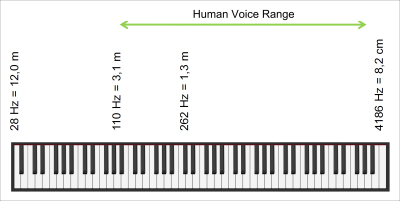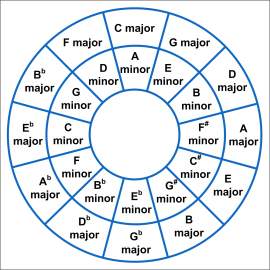
A musical note, is represented by a certain pitch. Pitch is the result of the vibration of a certain frequency (the higher the frequency, the higher the pitch). The note A as the basic tone of the musical system represents the pitch / frequency of 440 Hz.
Every doubling of the frequency indicates the tonal distance of one octave (the second note is one octave 'higher').
The standard 'concert pitch' in Western music today is 440Hz (the musical note a').
The first explicit reference to the tuning of middle C at 256 oscillations per second was probably made by a contemporary of J.S. Bach. The first person said to have accomplished this was Joseph Sauveur (1653-1716), called the father of musical acoustics. He measured the pitches of organ pipes and vibrating strings, and defined the "ut" (nowadays known as "do") of the musical scale at 256 cycles per second.
In Beethoven's time, the leading acoustician was Ernst Chladni (1756-1827), who explicitly defined C=256 as the scientific tuning. Up through the middle of the present century, C=256 was widely recognized as the standard "scientific" or "physical" pitch.
Interestingly, old German instruments of the period 1780-1827, and even replicas of those instruments, can only be tuned at A=430.
 |
| regular keyboard |
The Five-Line notation system was already introduced about 1000 years ago by Guido von Arezzo. The five lines have a musical 'distance' of one third.

Three different 'keys' / 'clefs' indicate which pitch is represented by the individual lines. Three clefs are used today:
- G-Clef (violin clef)
- F-Clef (bass clef)
- C-Clef (standard clef)
 |
 |
| G-Clef (violin clef) | F-Clef (bass clef) |
The demand by Czar Alexander at the 1815 Congress of Vienna for a "brighter" sound triggered the demand for a higher pitch from all the crowned heads of Europe. By 1850 chaos reigned in Europe with major European theatres at pitches varying from A=420 to A=460. Wagner even had the bassoon and many other instruments redesigned so as to be able to play only at A=440 and above.
Mozart tuned at precisely at C=256, as his A was in the range of A=427-430 and France passed a law in 1859 establishing A at 435. This standard was defined by the Paris Academy and confirmed by the Vienna Conference in 1885. It was called the 'international pitch'.
Verdi asked in 1884 in Italy to standardize A=432. But a British-dominated conference in Vienna in 1885 ruled that no such pitch would be standardized.
Actually A=440 has never been a real international standard before 1953. The first international conference to impose A=440 was organized by German Nazi Propaganda Minister Joseph Goebbels in 1939. Into the 1940s, all standard U.S. and European text books on physics, sound, and music took as a given the 'physical pitch' or 'scientific pitch' of C=256. Also Helmholtz defined C=256.
A congress of the International Standardizing Organization was held in 1953 in London to again attempt to impose A=440 internationally. The conference passed this resolution. but no Continental musicians who opposed the rise in pitch were invited, and the resolution was widely ignored. Professor Dussaut of the Paris Conservatory wrote they were catering to the U.S. jazz trade, which played at A=440 and above. A referendum by Professor Dussaut of 23,000 French musicians voted overwhelmingly for A=432 ... but A=440 became the standard now.
Note names apply to more than one pitch. Notes separated by one octave have the same names. The names will be repeated for every octave.
The note C is the pitch used for reference. The middle C is known as C4 and indicates the beginning of the 4th octave. Each note name between it and C5 are also in the 4th octave.
Historically, human beings started long ago with the awakening musical feeling and the human hearing abilities, to separate the range of one octave into certain smaller parts. The tonal difference of one octave (the doubling of the frequency) can be recognized very easily by mostly every person, but the smaller the tonal differences are, the more often 'non-musical' people are not able to differentiate.
In a long process people started to separate the octave into seven (with the octave: eight) basic tones building a musical scale. Later in this process, using different scales, the entire system of 12 half-tone-steps in one octave was developing.
 |
| regular 7 octave keyboard, frequency range and wave lengths |
The Circle of Fifths is a circle, surrounded by notes which ascend by fifths, following the notes in a clockwise direction.
The number of sharps and flats in a key can be seen in the circle. Clockwise every key has one more sharp, beginning with no sharp for the C-Major scale. Counter-Clockwise every key has one more flat, also beginning with the 12-o'clock position (C-Major) with no flat.
In the inner circle the corresponding parallel minor scale can be seen. This scale is built by the same notes as the corresponding Major scale, with a different first note of the scale.

The next step clockwise is always a perfect 5th. Counter-clockwise the next step is always a perfect 4th.